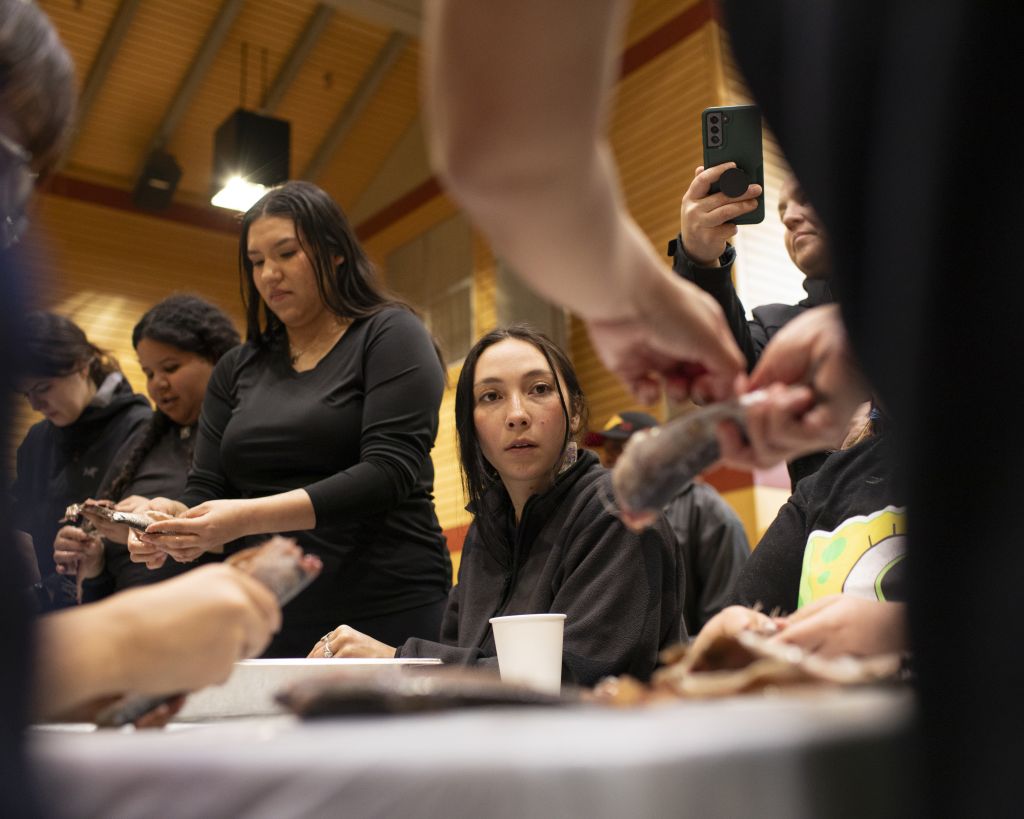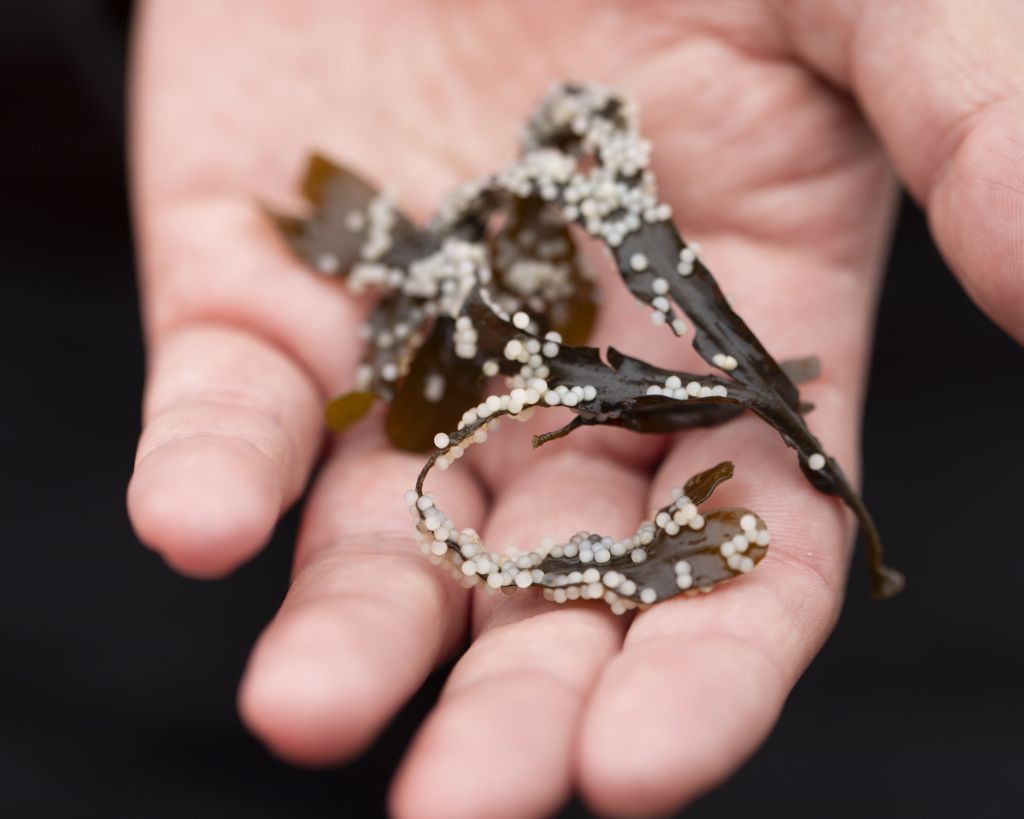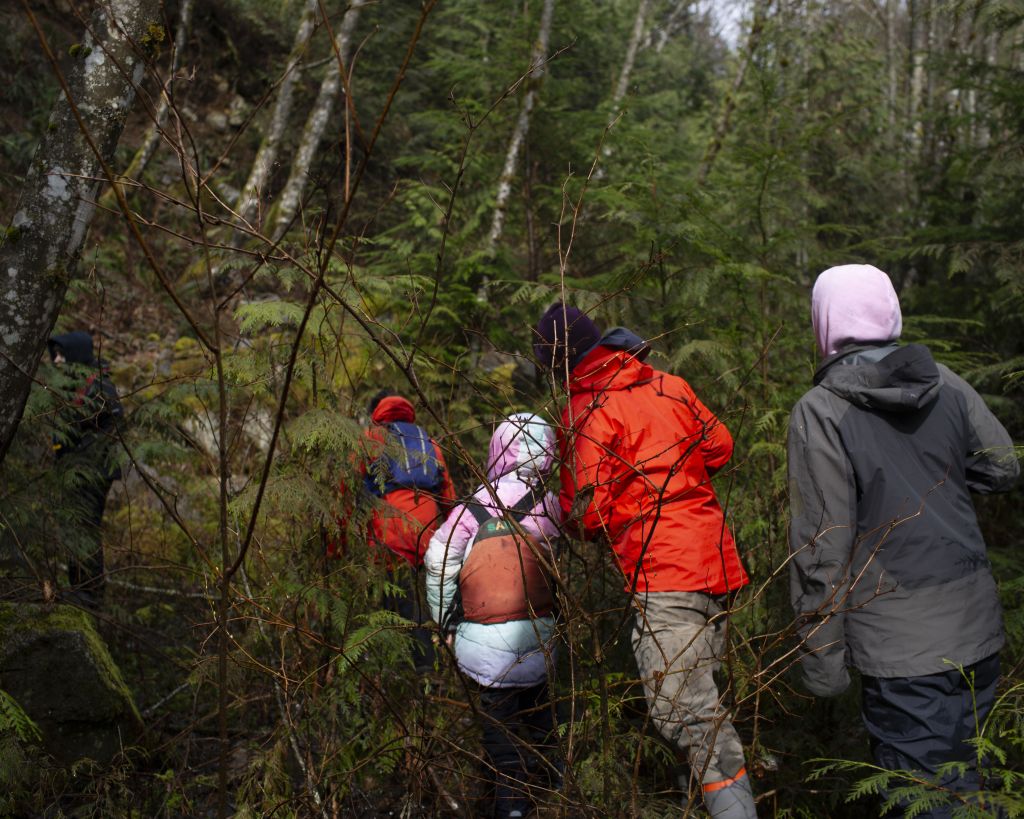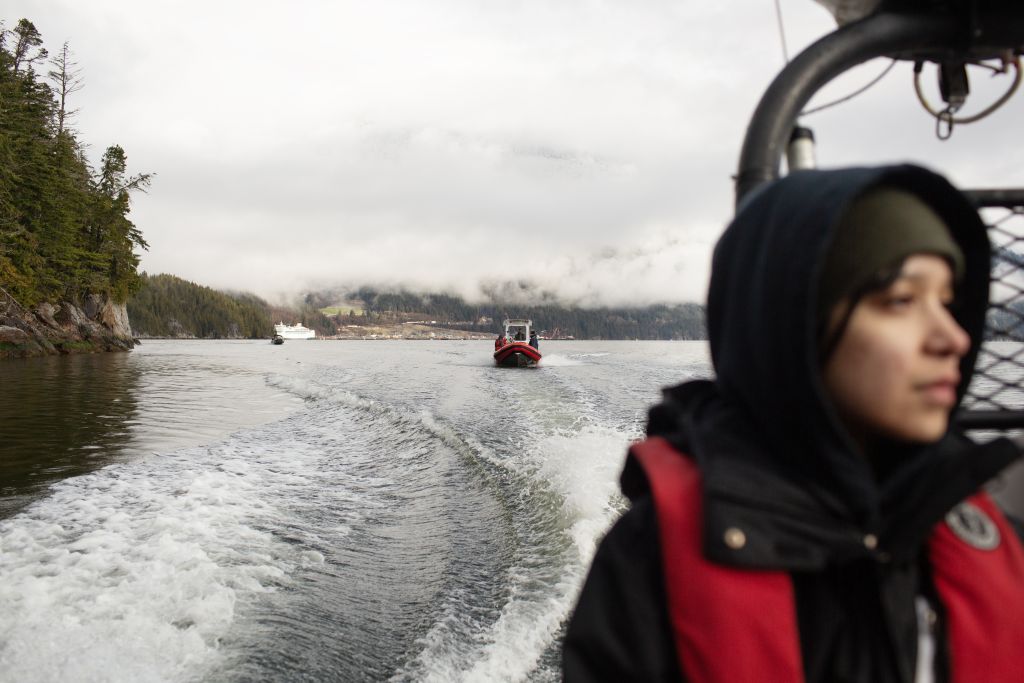
‘Horrific impacts’: as B.C. prepares to fast-track projects, a mining watchdog warns past mistakes could be repeated
Mining regulations and environmental assessments were developed to protect the environment and public health and...
Get the inside scoop on The Narwhal’s environment and climate reporting by signing up for our free newsletter.
Laughter echoes through Totem Hall in Sḵwx̱wú7mesh as Charlene Williams weaves between nieces and nephews, delivering ice and buckets for fish guts across a long, plastic-covered table.
The nation’s name is written in English as “Squamish.”
The “7” represents a glottal stop, which sounds like the pause in “uh oh.” It is pronounced like “Skw-HO-o-mish.”
“Auntie, auntie, look!” a child yells out as she proudly holds up her first gutted slhawt’ (herring) for Williams to see.
On April 10, members of Sḵwx̱wú7mesh Úxwumixw (Squamish Nation) and friends leaned in to learn how to clean and prepare slhawt’ — many for the first time.
Taking turns at the 20-person table, participants reached into crates to select silvery slhawt’, whose slender bodies flopped onto the work surface. With care, they cleaned and split each slippery fish, removing the orange roe before draping the meat over wooden racks for the smokehouse.

The gathering, ‘Mi chap ta7lt ta slhawt’’ (come learn about herring), celebrated the spring return of the fish and the rekindling of long-held traditions from their friends and relatives from Stz’uminus territories on Vancouver Island where slhawt’ have endured.
“Now’s not the time to be shy,” Williams says, inviting the 40 or so youth to the front to open with a song. “The herring aren’t shy — they’ve come to greet us.”
After years of quiet, the waters of Átl’ḵa7tsem (Howe Sound) are alive again with the silver flash of returning slhawt’. And with them, the Sḵwx̱wú7mesh people are rekindling traditional harvesting and food practices. In turn, these acts are reviving stories, songs, memories — and a way of being that remained dormant for generations.
Williams laughs as she recalls a comical moment with her daughter, who looked at her with alarm when Williams said they needed to collect herring eggs for food. “I don’t think that’s a good idea,” her daughter said. It turned out she’d misheard — thinking her mother meant heron eggs. Williams exploded with laughter.
“That’s how disconnected our people have been,” she reflects. “Diabetes and health challenges are everywhere because we don’t eat those superfoods anymore.”
Later, she adds, “Processing these fish is good medicine for us too.”


Since its inception as a small school event in 2020, Mi chap ta7lt ta slhawt has grown to include the broader Sḵwx̱wú7mesh community.
“This year it felt more like a festival,” Williams says. “Especially having our visitors, it was a powerful experience.”
Five years ago, developers at Nexen Beach spotted ch’éḿesh (herring eggs) and reported it to the Squamish Valley Elders group.
The sighting caught the attention of Kiyowil Bob Baker, who remembered harvesting herring eggs in Kwakwa̱ka̱ʼwakw territories, where his wife is from. He called Williams with an idea: get the local St’a7mes School involved and bring back traditional harvesting practices.

In fact, the herring had been returning every spring for about a decade already — local citizen scientist John Buchanan took it upon himself to record data on where the slhawt’ spawn each year — but since Fisheries and Oceans Canada never acknowledged herring in Átl’ḵa7tsem, for many it was a surprise.
Williams teamed up with her fellow teacher, Matthew Van Oostdam, and — after speaking with Elders, conservation groups and Buchanan — they pieced together their best guess at where achcháwten (spawning) might happen. When the timing felt right, they gathered a group of youth and laid two trees off the local Nexen Beach pier (now Sp’akw’us Feather Park), hoping the slhawt’ would come.
The practice of laying trees for herring eggs has been a tradition up and down the coast — from the Lingít, Haida and Tsimshian in Alaska to the Port Gamble S’Klallam Tribe in Washington state. Herring lay their eggs by attaching them to surfaces in the intertidal zone, so by laying anchored trees in the water right before the annual spawning event, harvesters provide herring with ample surface area for their ch’éḿesh to cling to.
Just six days after laying a cedar and hemlock tree off the pier, the branches were covered in ch’éḿesh.

“We were so surprised,” Williams says. “But we prayed a lot — and we had ceremony.”
She had also been learning about the timing of the spawn and its connection to lunar patterns, observing that slhawt’ seem to spawn on or near the first quarter or third quarter of the moon cycle.
The following year, she placed the branches again — and now, she was right on time.
The school soon wove slhawt’ season into their seasonal learning. In the spring, students headed out on the water — where they already harvest rose hips and cattail bullrush — now also keeping watch for signs of slhawt’.
Van Oostdam, a land-based coordinator at St’a7mes School, was so taken by the return of the forage fish to Átl’ka7tsem that he developed the character “Harriet the Herring” — a beautiful silvery herring with big eyelashes, who teaches kids about the importance of slhawt’ to the Átl’ka7tsem ecosystem.


“I didn’t know that they’d listen to me, but I knew they’d listen to Harriet,” he says.
During the pandemic’s relentless virtual learning conditions, Van Oostdam started sending letters to his students, signed off by Harriet the Herring. She soon became a hit.
In 2024, Van Oosten co-authored Tem Lhawt’: Time of the Herring with Welwaltenaat Myia Antone, illustrated by Latashkinem. The children’s book presents two parallel but separate stories — one in Sḵwx̱wú7mesh sníchim, the other in English — both following Harriet and her auntie. All profits support Sḵwx̱wú7mesh language revitalization.
“It’s cool to think that in five years, kids know who Harriet is, that you can taste the eggs, that herring spawn every year here,” Van Oostdam says.

As a keystone species, slhawt’ are also essential to the broader ecosystem — supporting a complex web of life across land and sea. Chinook and coho salmon feed on them, as do harbour seals, humpback whales, seabirds and bears. Their ch’éḿesh nourish everything from gulls to crabs. The health of slhawt populations ripples outward, shaping the well-being of entire coastal food systems.
But in British Columbia, slhawt’ have been in decline for decades because a range of pressures including industrial fishing, habitat loss, pollution, warming oceans and increased predation by marine mammals.
In the Strait of Georgia, the commercial sac roe fishery has had a major impact, targeting mature, egg-bearing females before they spawn. While the roe is exported, the rest of the fish is often ground into animal feed.


Critics say the practice undermines herring recovery and ignores warnings from Indigenous leaders and conservation groups.
In 2022, more than 800,000 herring were killed at salmon farms in the province, after being caught in hydrolicers — high-pressure machines used to blast sea lice off farmed salmon. The delicate fish reportedly had their eyes blown out by the force of the water, raising serious concerns about the impact of aquaculture on wild stocks like slhawt’.
Without genetic testing, we don’t know whether the slhawt’ in Átl’ḵa7tsem are the same as those in the Strait of Georgia, but for now, a small team of Sḵwx̱wú7mesh Úxwumixw members, along with project coordinator Van Oostdam have continued the work of Buchanan, surveying occurrences of ch’éḿesh in Sḵwx̱wú7mesh waters.


On a chilly, overcast day in March, the group went out, wetsuits and snorkels, searching for slhawt’ in the usual spots at the northern end of Átl’ka7tsem.
Among the 10 sites they visit weekly, one stands out: the Woodfibre LNG site — where slhawt’ have spawned extensively since Buchanan’s earliest surveys. There, the team is required to check in with security for safety precautions, complete paperwork outlining their activities and often face questioning about their intentions.
“It’s an onerous process,” Van Oostdam says.

Along the same stretch of shoreline — part of a spawning site that extends from the Woodfibre LNG area to Foulger Creek — two log booming tenures have been approved for forestry companies, set to expire in 2026. So far, the sites have remained inactive, said Van Oostdam, but recent work on a nearby forestry road suggests log storage may be imminent.
In a report, the tl’ka7tsem / Howe Sound Marine Stewardship Initiative wrote, “This is extremely concerning, as log booms can destroy herring spawning habitat and other marine life in the intertidal zone.”
“It cannot be stated more clearly that this shoreline from Woodfibre Creek to Foulger Creek is important herring spawn habitat — this shoreline consistently has the highest density of herring spawn documented within our study region.”
This year, for the first time, Williams and Van Oostdam invited youth and community members to help select cedar and hemlock trees, tie on rock anchors with cedar strips, attach buoys and lay the trees in the water at Foulger Creek — one of the most consistent spots for ch’éḿesh.

“This year was more about passing on the knowledge,” Van Oostdam explains during one of the dedicated Sunday outings in March.
During the day’s closing circle, Williams offers gratitude and thanked the youth for coming out on the water during a rainy morning.
“With the sun and rainbow over us, that was Creator looking down on us and giving us his blessing. It was no coincidence,” she says.
“You won’t understand now but you being here is really important and doesn’t go unnoticed,” she adds as the youth listen closely. “I’m proud that you’re here because in the future, people will talk about the time the herring came back to us and there were these people who looked after them — and that’s you.”

At the herring celebration in April, Kiyowil Bob Baker — now in his 90s — scoots to the centre of the performance space, where Williams gently wrapps him in a blanket.
Performers sing a newly composed slhawt’ song, which had come to cultural and language teacher Tsitsayxemaat (Rebecca Duncan) just the year before, while working with children at St’a7mes’ sister school, Xwémélch’stn Etsímxwawtxw (Capilano Little Ones).
As dancers sway around him to the new song and a projection of silvery slhawt’ lights the room, it feels as though the herring themselves are circling the gathering in celebration.
The display, Williams explains, was for Kiyowil, to honour his guidance and work around revitalizing slhawt’ in the community.
“My hope is that I can one day share the same guidance as you,” she tells him.

Apparently, Kiyowil has already put in a request for next year: that the dancers use clappers to keep time with the drums. Williams chuckles over the phone as she shares the update.
As the celebration continues to grow, Williams hopes what began as a small school event will one day become something the whole of Sḵwx̱wú7mesh takes part in.
“It’s a powerful thing to come together and remember the good things happening in the world,” she says.
“We’re always worrying about the state of things — but we need to share the good stories, too. That’s what inspires us and keeps our fire going. It’s these stories — the herring coming back, and bringing our community together.”
Since the election of Prime Minister Mark Carney in April, Alberta and the federal government have been talking about a “grand bargain” to balance rapid...
Continue reading
Mining regulations and environmental assessments were developed to protect the environment and public health and...

Climate change and urban sprawl are blurring the lines between bear country and our front...

Last week, Queen’s Park passed bills to create special zones for industry and block green...
